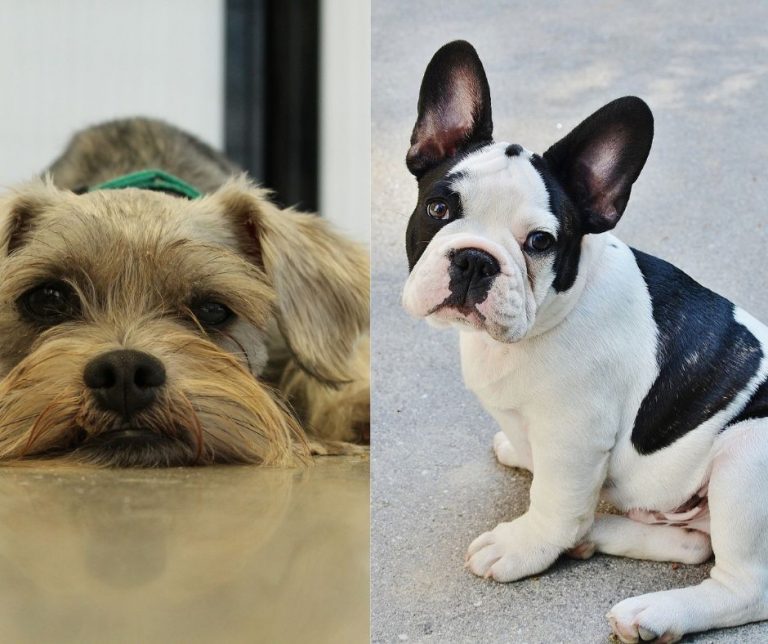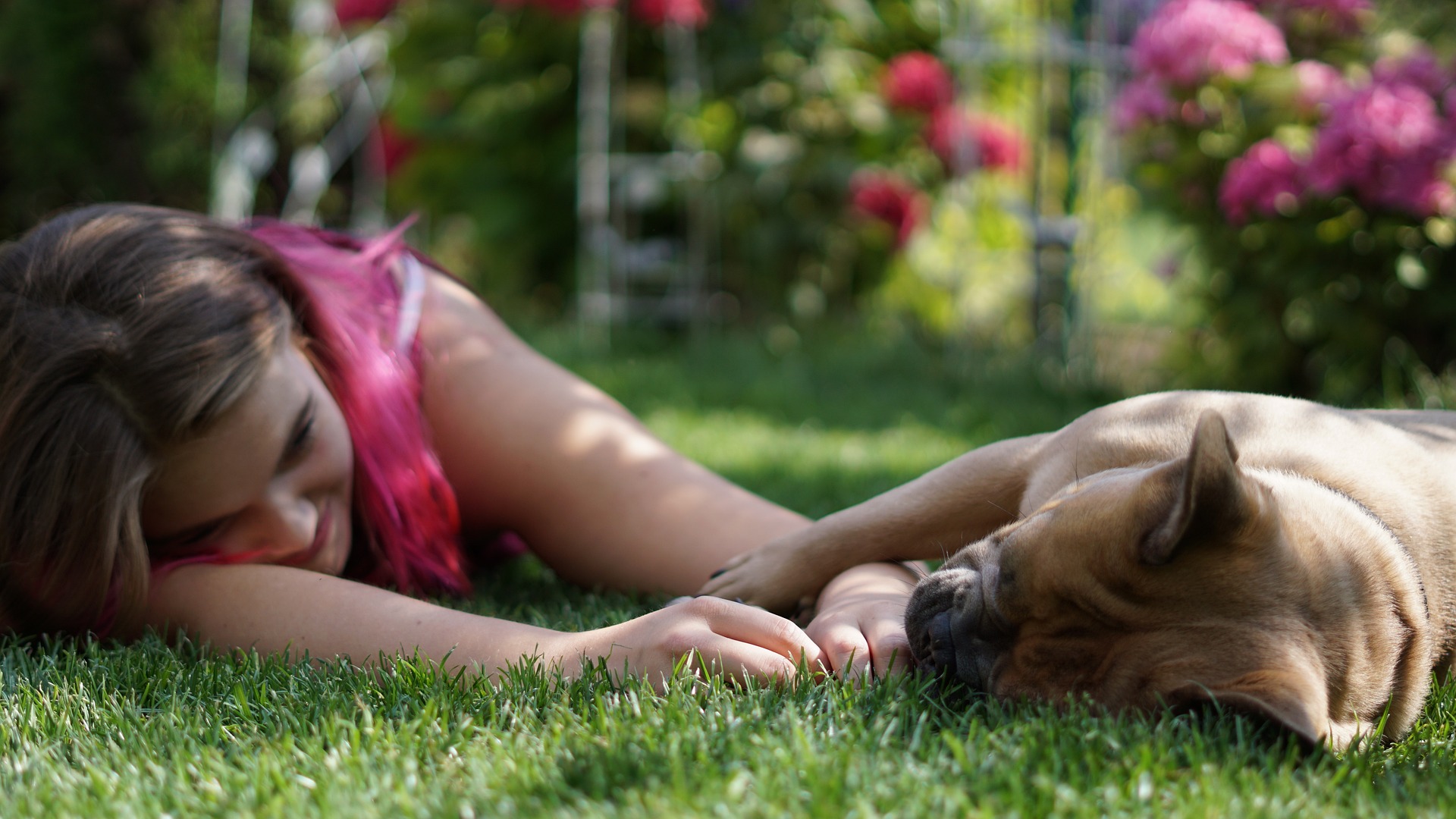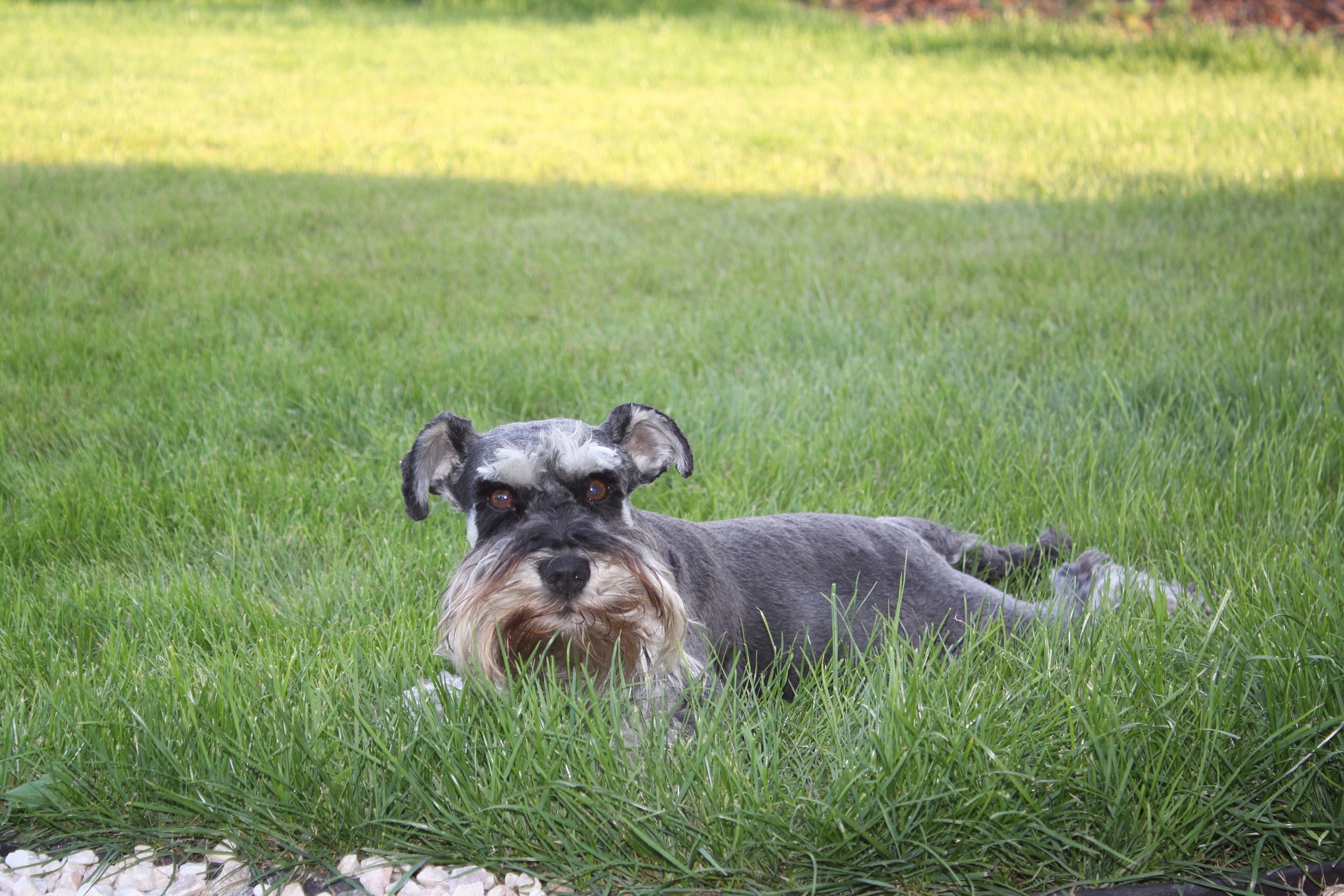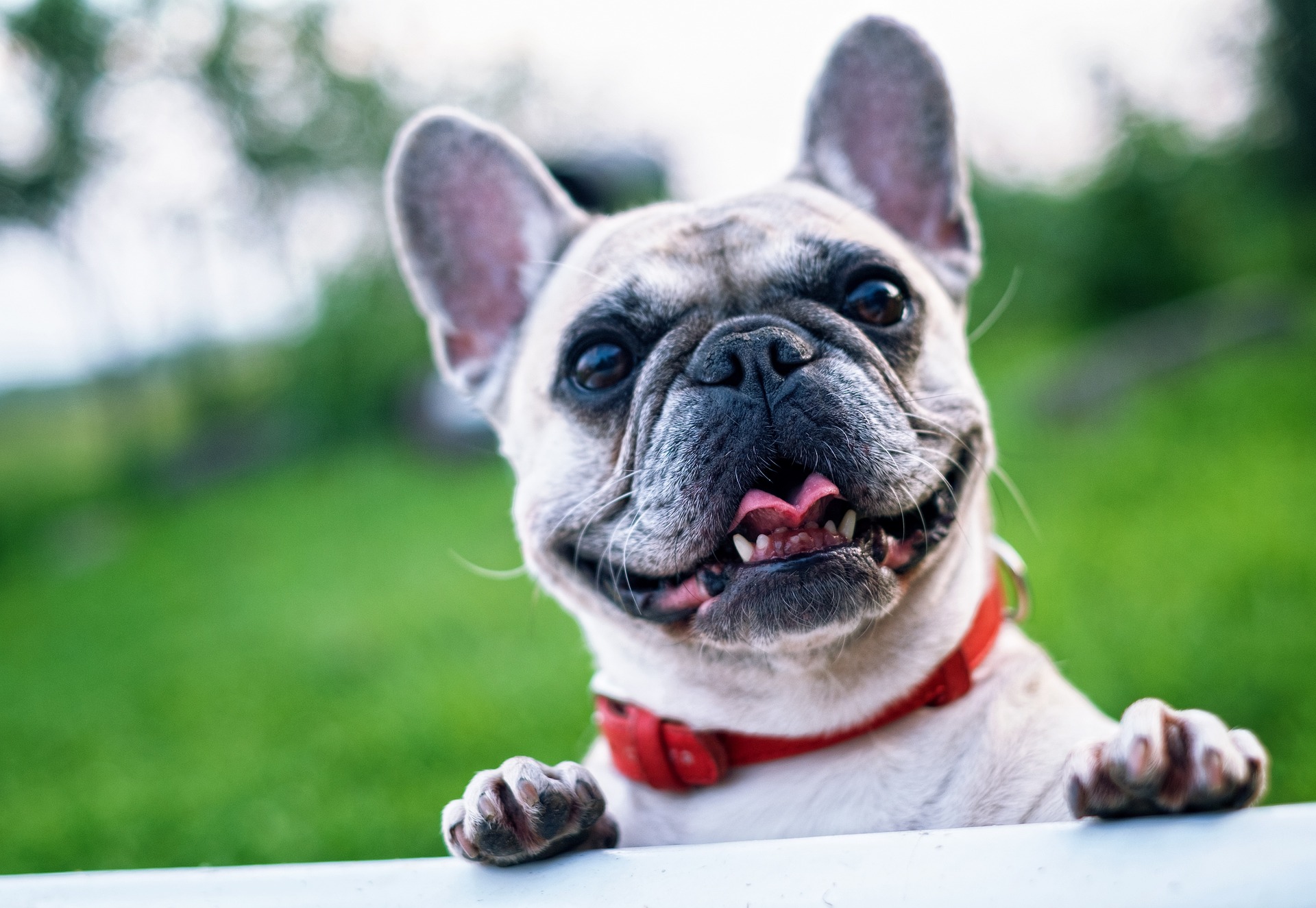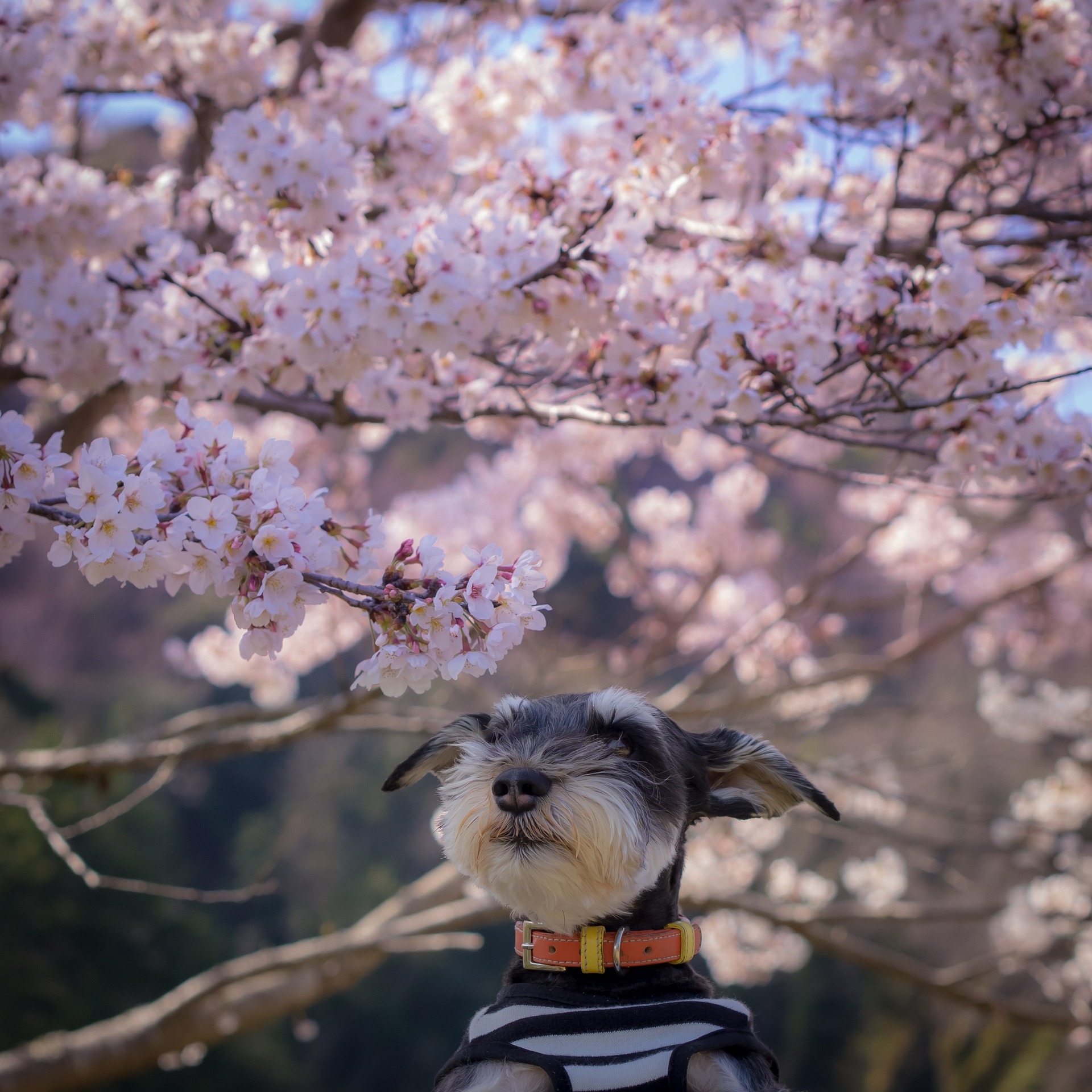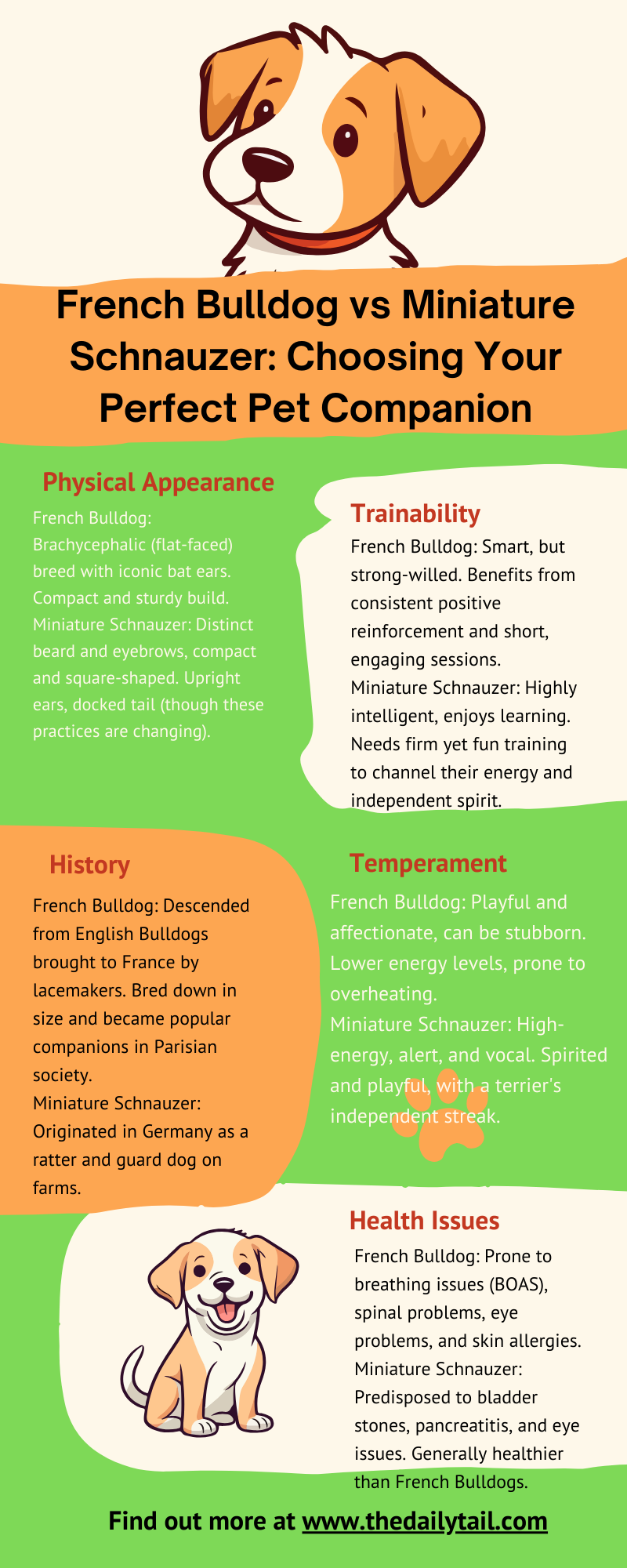Couch potato snuggler vs. spirited adventurer – are you more Frenchie or Schnauzer? Let’s explore these lovable opposites. An experienced dog owner like myself knows there is a family for both popular dog breeds. Which one fits your lifestyle more? Let me guide you through your decision.
When choosing a canine companion, prospective pet owners often compare breeds to find the perfect match for their lifestyle. Two popular choices for many families are the French Bulldog and the Miniature Schnauzer. These breeds are known for their unique personalities and distinct physical characteristics, making them endearing to many. The French Bulldog, with its bat-like ears and robust build, exudes charm and a laid-back temperament. In contrast, the Miniature Schnauzer boasts a spirited personality in a wiry-coated, smaller frame, complete with distinctive eyebrows and a beard.
Understanding the differences between the French Bulldog and the Miniature Schnauzer is crucial for potential owners to ensure a harmonious match between their new four-legged friend and their home environment. The French Bulldog often thrives in a less active setting, due to its lower need for exercise, whereas the Miniature Schnauzer is more energetic and requires regular activity. Despite their size, each breed has specific care requirements, common health concerns, and ideal living environments that should be contemplated before making a choice. Let’s take a look at the French Bulldog vs Miniature Schnauzer breed comparison.
Key Takeaways
- The French Bulldog offers charm with a calm demeanor, while the Miniature Schnauzer is more energetic and agile
- Both breeds require specific care that matches their physical and temperament traits to ensure their well-being
- Choosing the right breed involves considering environment, activity level, and potential health issues to find a suitable companion
Breed Origins and History
When choosing between a French Bulldog and a Miniature Schnauzer, it helps to understand where they come from, how they emerged as distinct breeds, and their unique histories. Let’s peek into their backgrounds and see how these breeds became the beloved dogs they are today.
French Bulldog History
The French Bulldog dog breed has its roots in England, primarily in the lace-making regions where they were once known as the smaller bulldogs. Lace workers brought them to France during the Industrial Revolution, and the breed developed its ‘French’ moniker. The French Bulldog’s history is marked with a transition from a working-class favorite to being an adored companion for royalty and the artistic elite.
Miniature Schnauzer History
Originating in Germany, the Miniature Schnauzer was bred down from the Standard Schnauzer. They were initially developed for farm work, ratting, and guarding properties. Bred from a mix that included the Affenpinscher and possibly the Poodle, they emerged as a distinct breed by the late 19th century, excelling in both their work ethic and companionship. We have to note, nowadays, there are different sizes of the Schnauzer breed group. You can find the Standard Schnauzer and the Giant Schnauzer.
Breed Popularity
- French Bulldog: Currently, this breed enjoys a high popularity rank, often listed in the top five breeds in the United States by the American Kennel Club (AKC). In 2022, the dog was voted as the most popular dog breed by the American Kennel Club
- Miniature Schnauzer: They have consistently maintained a presence in the top 20 dog breeds, signaling enduring popularity as a versatile and family-friendly companion
Naming and Classification
- French Bulldog dog breed: They are known simply as the “Frenchie” and are classified by the AKC within the Non-Sporting Group
- Miniature Schnauzer: This breed is often affectionately referred to as “the Schnauzer” and is categorized in the Terrier Group, reflective of its alert and spirited nature
Both breeds are recognized purebreds, with histories that shed light on their character and the roles they’ve played in society. Whether one is charmed by the relaxed yet alert French Bulldog or the vivacious and perky Miniature Schnauzer, it’s clear these dogs have staked a claim in the hearts of dog lovers through the ages.
Physical Characteristics
In comparing the French Bulldog vs Miniature Schnauzer, you will notice clear distinctions in their build and appearance. Here’s a glance at how these breeds compare in size, their coats and colors, and other distinctive features that set them apart.
Size Comparison
The French Bulldog generally maintains a compact build. Height-wise, they stand 11 to 12 inches at the shoulder, and regarding weight, a healthy adult usually ranges between 20 to 28 pounds. On the other hand, the Miniature Schnauzer appears slightly taller and leaner, standing 12 to 14 inches and weighing in at approximately 11 to 20 pounds. Each breed’s size is a strong reflection of its unique background and breeding purpose.
Coat and Colors
Coat-wise, these two breeds show quite a contrast. The French Bulldog has a short, smooth coat with minimal shedding, which is quite easy to maintain. Their color palette varies and includes brindle, fawn, white, and combinations of brindle and white. There is also a Blue French Bulldog, but this is a rare occurrence.
Meanwhile, the Mini Schnauzer boasts a wiry, dense coat that requires regular grooming to maintain its distinctive look. They typically show off in salt and pepper, black and silver, or solid black hues. So, when you look at coat type and coat length, these two are completely different.
Distinctive Features
French Bulldogs are known for their broad, square head, short snout, and bat-like ears which contribute to their characteristic ‘smushed’ appearance. Unfortunately, these features can lead to brachycephalic syndrome, which impacts breathing. They also sometimes have hemi-vertebrae, which affects their spine. Miniature Schnauzers showcase a distinguished look too, with their bushy eyebrows, beards, and sharp, alert expression. Their body, square in proportion, coupled with their wiry coat, requires regular grooming but doesn’t typically come with the health concerns seen in French Bulldogs’ distinctive features.
Temperament and Personality
When choosing between the French Bulldog vs Miniature Schnauzer, understanding their temperaments and personalities is crucial. French Bulldogs are known for their affectionate nature, while Miniature Schnauzers are prized for their intelligence and spirited character.
Behavioral Traits
French Bulldogs are affectionate and playful, often forming strong bonds with their owners. They can be a bit territorial, which makes for a good watchful presence at home. Miniature Schnauzers, on the other hand, showcase a bold and alert temperament. They are energetic and require more mental stimulation to prevent boredom-related behaviors.
- French Bulldog:
- Social and loving with family
- Can be protective of their home environment
- Miniature Schnauzer:
- Active and alert, with a spirited demeanor
- May show some stubbornness, but this is part of their charming character
Compatibility with Families
Both breeds are generally family-friendly, but they have different dynamics when interacting with family members. French Bulldogs are kid-friendly and dog-friendly, making them suitable for homes with children and other pets. They revel in human interaction and are generally well-behaved around guests.
Miniature Schnauzers also do well with families and are playful companions for children. They can be a bit more territorial than French Bulldogs, so early socialization is important to ensure they are good with strangers and other dogs.
- French Bulldog:
- Excellent with children and other pets
- Adaptable to various household types
- Miniature Schnauzer:
- Enjoys lively play, fitting well into active households
- Can exhibit assertiveness requiring diligent socialization
Training and Intelligence
Training and intelligence are areas where both breeds shine, albeit in different ways. Miniature Schnauzers are highly intelligent and capable of learning a variety of commands and tricks, which makes them relatively easy to train. They respond well to positive reinforcement techniques and enjoy the challenge of obedience work.
French Bulldogs, while intelligent, often show a stubborn streak when it comes to training. Consistency and patience are key, but they may not always have the drive for complex training like their Schnauzer counterparts.
- French Bulldog:
- Intelligent but may show an independent nature during training
- Early and consistent training routines are recommended
- Miniature Schnauzer:
- Known for their obedience and eagerness to learn
- Thrive with engaging and varied training methods
Care and Maintenance
When welcoming a furry friend into your home, understanding their unique care and maintenance needs ensures a happy, healthy life together. From daily runs in the park to allergy considerations, keeping up with your pet’s necessities can be a delightful part of your daily routine.
Exercise Needs
French Bulldogs: Known for their laid-back personality, French Bulldogs require less exercise. A daily, leisurely walk will usually suffice, complemented by some playtime at home. Their energy level is lower, so they’re content with cuddles and short bursts of indoor play.
Miniature Schnauzers: These spirited dogs have a higher energy level and require more time for exercise. Regular walks, a bit more brisk and frequent than those for their French Bulldog friends, along with ample playtime, helps manage their liveliness.
Grooming Requirements
French Bulldogs: Their short hair means minimal shedding, making maintenance relatively easy. Routine brushing can keep their coat healthy, and they often require only occasional baths. It’s important to clean their facial wrinkles to prevent irritation or infection.
Miniature Schnauzers: With their wiry coat, they are often considered good for people with allergies, owing to less shedding. Regular grooming is a must, which includes clipping or hand-stripping to maintain their distinctive look. They need consistent brushing and the occasional bath to stay clean and tidy.
Health and Lifespan
French Bulldogs: They have a shorter lifespan of 10-12 years. Health issues like hip dysplasia and patellar luxation can be of concern, as well as breathing problems due to their brachycephalic nature. Regular check-ups with the vet can help manage health problems.
Miniature Schnauzers: Typically living for 12-15 years, they’re generally a hearty breed. However, they’re not immune to health problems, with potential for hip dysplasia and allergies. It’s crucial for them to have an ongoing relationship with a vet to monitor and treat any health issues that arise.
Living Environment
When it comes to the French Bulldog and the Miniature Schnauzer, their adaptability to living environments is as distinct as their personalities. Navigating the right fit for these breeds involves considering their energy levels and temperament, especially in an apartment versus a house setting and their adaptability to various climates.
Apartment vs House Living
Both breeds can adapt to apartment living, but French Bulldogs are particularly well-suited due to their lower energy levels. They are compact and generally less active, which means they are comfortable in smaller spaces and don’t require a yard. Frequent walks and play sessions are enough to keep them happy and healthy.
In contrast, Miniature Schnauzers have a higher energy level and may appreciate more space, like that of a house with a yard, to burn off their vigor. However, if a Schnauzer’s energy is properly channeled through walks and interactive play, they too can adapt just fine to apartment life. These terriers can be territorial, so early socialization is key to help them become well-mannered indoor companions.
Climate Adaptability
When it comes to weather, it’s important to note that each breed has its preferences and limitations. French Bulldogs are not the best fans of extreme temperatures—both hot and cold weather can pose health risks due to their short snouts, which can lead to difficulty breathing. During sizzling summers, air conditioning and ample shade are must-haves, whereas, in wintery conditions, they might need a sweater to stay warm.
Miniature Schnauzers are a bit more robust in terms of climate adaptability but still require protection from severe conditions. They can handle cooler weather better than Frenchies but should not be left outside in cold weather without supervision. In hot weather, similarly to the French Bulldog, they should be kept cool to prevent overheating.
When one brings either breed into their home, attention to these details ensures a harmonious and comfortable living environment.
Ownership Considerations
When choosing between a French Bulldog and a Miniature Schnauzer, prospective owners should consider several factors such as their experience with dogs, the financial commitment, and selecting a breed that aligns with their lifestyle.
First-Time Owners
French Bulldogs are often recommended for first-time dog owners due to their easygoing nature and ability to thrive in various living environments, including apartments. They’re friendly and affectionate with their owners, but they can sometimes be stubborn. On the other hand, Miniature Schnauzers are intelligent and eager to please, which can make training more manageable for novice owners. However, they do have a high energy level and playfulness, necessitating consistent training and socialization.
Budgeting for Your Dog
| Cost Consideration | French Bulldog | Miniature Schnauzer |
|---|---|---|
| Initial Price | High | Moderate |
| Maintenance | Moderate to high | Moderate |
| Health Problems | Prone to respiratory, joint, and skin issues | Typically healthy, but can have eye issues and urinary stones |
| Activity Needs | Low | Moderate to high |
| Potential for Weight Gain | High | Moderate |
French Bulldogs tend to be pricier both in initial cost and potential healthcare expenses due to their susceptibility to a range of health problems. Miniature Schnauzers are generally more affordable, but they may still incur costs with their grooming needs due to their distinctive coats.
Choosing the Right Breed
| Breed Characteristic | French Bulldog | Miniature Schnauzer |
|---|---|---|
| Kid Friendly | Yes | Yes |
| Pet Friendly | Yes, with proper introduction | Yes, but can have a high prey drive |
| Stranger Friendly | Usually friendly | Reserved initially |
| Adaptability to Being Alone | Moderate | Low to Moderate |
For those who have children or other pets, both breeds can integrate well into the family with the French Bulldog being typically more kid friendly and pet friendly, showing a more easygoing disposition. Miniature Schnauzers may require more socialization due to their territorial instincts. When it comes to being alone, French Bulldogs may cope slightly better, but neither breed should be left isolated for long periods. Their personalities are best suited to households where they can be part of daily activities and family interactions.
Common Health Concerns
When considering a French Bulldog or a Miniature Schnauzer, one should be aware that both breeds have their share of inheritable health issues. It’s crucial for potential dog owners to understand these concerns to ensure their future pet lives a happy and healthy life.
Inherited Conditions
French Bulldogs:
- Brachycephalic Syndrome: Due to their short nose and flat face, French Bulldogs often have breathing difficulties
- Intervertebral Disk Disease: They can suffer from spinal issues, given their distinctive body structure
- Hip Dysplasia: This can lead to arthritis or lameness, and Frenchies are predisposed to it
- Patellar Luxation: Their kneecaps may slide out of place, causing discomfort and affecting mobility
- Cleft Palate/Elongated Soft Palate: Birth defects like cleft palate are common in brachycephalic breeds
Miniature Schnauzers:
- Pancreatitis and Obesity: They can easily gain weight, which may lead to pancreatitis
- Von Willebrand’s Disease: A blood clotting disorder that can be present in the dog breed
- Cataracts: Eye issues such as cataracts can develop, leading to vision impairment
- Progressive Retinal Atrophy (PRA): This degenerative eye disorder leads to blindness in some cases
Potential Health Tests
By being proactive with health testing, owners can address or even prevent some of these conditions. Here’s what they can consider:
For French Bulldogs and Miniature Schnauzers:
- Hip evaluation to screen for hip dysplasia
- Ophthalmologist evaluation to catch any early signs of cataracts or PRA
- Patella evaluation especially for French Bulldogs, to check for patellar luxation
Additional for Miniature Schnauzers:
- Von Willebrand’s Disease DNA test is available to check for this particular condition
- Blood panel to monitor for signs of pancreatitis, especially in dogs that are overweight
The lifespan of French Bulldogs typically ranges between 10 to 12 years, while Miniature Schnauzers often enjoy a longer span of 12 to 15 years. Understanding and attentively managing their health concerns can contribute to a quality life and potentially even extend their years beside their beloved humans.
Breed Comparisons and Choice
Choosing between a French Bulldog and a Mini Schnauzer involves understanding their unique characteristics. Each breed presents its own set of qualities that cater to different family environments, activity levels, and grooming commitments.
Behavior and Temperament
French Bulldogs are known for their affectionate and playful nature, often forming strong bonds with their family members. They typically exhibit less aggression and are relatively easy to train, making them a beloved choice for many. On the other hand, Miniature Schnauzers are alert and spirited. They possess a higher tendency for barking and can serve as vigilant watchdogs. Despite this, both breeds are friendly and possess a playful spirit that makes them suitable for families.
- Aggression Levels: French Bulldogs – Low | Miniature Schnauzers – Moderate
- Barking Tendency: French Bulldogs – Low | Miniature Schnauzers – High
- Training: French Bulldogs – Relatively easy | Miniature Schnauzers – Can be strong-willed but trainable
Physical Needs and Activities
Miniature Schnauzer dogs were bred for hunting and hence have higher energy levels compared to French Bulldogs, which require less exercise. Schnauzers thrive with interactive play and activities that channel their intelligence and hunting instincts. French Bulldogs, with their brachycephalic nature, require moderate physical activity to prevent overexertion. Exercise is crucial for both breeds to prevent behavioral issues.
- Exercise Needs: French Bulldogs – Moderate | Miniature Schnauzers – High
- Playfulness: French Bulldogs – High | Miniature Schnauzers – High
- Activity Suitability: French Bulldogs – Short, low intensity | Miniature Schnauzers – Longer, interactive play
Conclusion
Deciding between a French Bulldog and a Miniature Schnauzer comes down to understanding their unique traits and how they fit into an individual’s lifestyle. French Bulldogs, with their compact size and affectionate nature, make excellent companions for city dwellers and those without spacious homes. One should keep in mind their 10-12 years lifespan and potential for health issues related to breathing due to their flat faces.
In contrast, Miniature Schnauzers bring a bundle of energy and playfulness into the home. They are known for a slightly longer lifespan of 12-15 years and boast a sturdy build, making them a robust option for families. Their intelligence and trainability stand out, but they do require regular grooming to maintain their wiry coat.
When considering maintenance, French Bulldogs require less exercise but more attention to temperature, as they’re prone to overheating. Miniature Schnauzer dogs need regular mental and physical stimulation but are generally low-shedding, which could be a relief for those with allergies.
Nowadays, a lot of pet parents and dog owners looking for a small dog might look at the Miniature Schnauzer, French Bulldog, Yorkshire Terrier, Boston Terrier, Miniature Poodle, or others.

